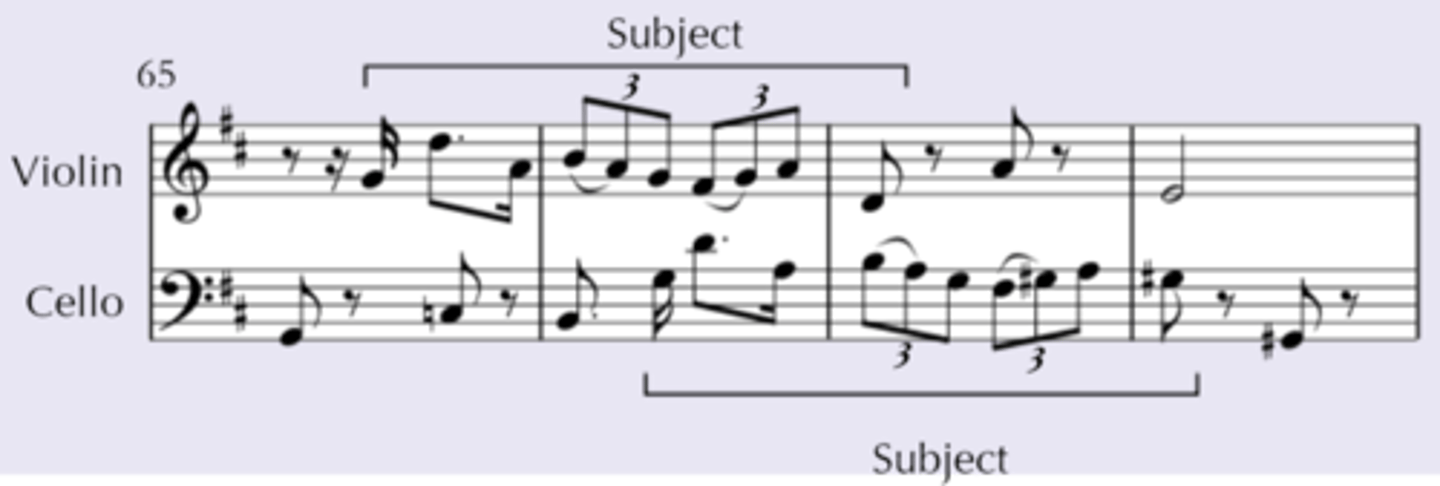Evie Music - J.S. Bach
1/34
Earn XP
Description and Tags
Thanks to Evie for the set. Ported over from Quizlet.
Name | Mastery | Learn | Test | Matching | Spaced |
|---|
No study sessions yet.
35 Terms
J.S. Bach birthplace?
Germany
Which genres did Bach NOT write in?
opera
What is Bach's music known for?
1. Instrumental music (e.g. Brandenburg Concerto)
2. Sacred Choral music (e.g. masses)
3. Long flowing expressive melodies
4. Contrapuntal music (e.g. fugues)
Which instruments feature in Bach's works?
keyboard instruments (e.g. harpsichord & organ)
When was Brandenburg Concerto No.5 written?
around 1721
How many Concertos did Bach write?
6
What structure is Brandenburg Concerto No.5?
Concerto Grosso
What makes up a Concerto Grosso?
Concertino + Ripieno
What instruments make up the Concertino in Brandenburg Concerto No.5?
1. solo violin
2. solo flute
3. harpsichord
What instruments make up the Ripieno in Brandenburg Concerto No.5?
string orchestra
What instruments play the Basso Continuo in Brandenburg Concerto No.5?
1. harpsichord (when not playing solo)
2. cello
3. double bass
What key is Brandenburg Concerto No.5 written in?
D major
Why is a harpsichord important in Brandenburg Concerto No.5?
1. harpsichord's prominent solo role is unusual for the period
2. the part is complex at times (playing quick semiquavers in scalic patterns (from bar 42)) & is completely unaccompanied (bars 163-176)
3. in some place harpsichord completes the harmony by realising the figured bass
4. harpsichord player directs ensemble (instead of conductor)
5. Sometimes plays trills in both hands at the same time
What musical form is the 3rd Movement of Brandenburg Concerto No.5?
Gigue & Fugue characteristics
What instrument plays the subject (main idea) first?
Violin
What instrument plays the subject (main idea) second?
Flute
What tempo is the 3rd Movement of Brandenburg Concerto No.5?
allegro (lively & fast)
What form is the 3rd Movement?
ternary (ABA)
What key is Section A (bars 1-78)?
D major (tonic) with brief sections in A major (dominant)
What key is Section B (bars 79-233)?
- B minor (relative minor of D major),
- section ends with perfect cadence in B minor
What key is Section final A (bars 234-310)?
D major (tonic)
What structure is seen throughout the 3rd movement of Brandenburg Concerto No.5?
Ritornello
main melodic section (bars 1-29) is repeated throughout piece with contrasting sections in between
Which instruments start the fugue?
concertino
At which bar does the fugue pass to the ripieno?
29
Name 4 musical devices Bach used in 3rd movement of Brandenburg Concerto No.5.
1. Sequencing
2. Pedal point / note
3. Stretto
4. Trills
Where is sequencing seen?
bar 137
instruments: flute & ripieno violin
pattern is repeated in each bar, moving up a tone each time

Where is pedal point / note seen?
bar 90-95
instruments: flute & cello
cello repeats pedal note while melody changes in flute
effect: creating dissonance when the harmony changes above it

Where is stretto seen?
bar 64-68
instruments: violin, viola & cello
Fugue subject is overlapped i.e. 1 instrument starts playing the subject before the previous 1 is finished
effect: builds up intensity of texture

Where are trills seen?
bar 19
instruments: harpsichord

Name 2 features of the melody.
1. conjunct (stepwise) melody
2. scalic rising sequences in harpsichord
What is another way of describing the tonality of this piece?
diatonic
What cadences announce the end of each section?
Perfect
What is the metre of this piece?
2/4 but could be notated in 6/8
What rhythms are used throughout this piece?
triplets and dotted rhythms
What group of musicians played this music?
Played by a small chamber group